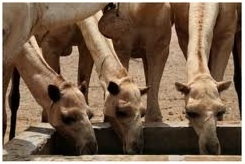
In principle feeding camels is not different from feeding ruminants. Camels are pseudo ruminants. Camels posses remarkable ability to utilize tough feeds. They consume mainly vegetation which are thorny shrubs and herbs with limited tiny leaves. The lips are thick and the upper lip is divided and very sensitive, suited to pick leaves from small branches i.e. nibbling. The small tongue is good enough to hold the leaves. The camels can consume even the little branches that contain thorn quite comfortably.
The stomach capacity is as in cattle approximately 11 to 15% of body weight. The camel has no gall bladder therefore no bile salt to assist in digestion of fat. Feed resources are desert type of vegetation which are mainly shrub. Most camels are browsers with a few exceptions that are grazers.
Food requirements are not yet established as in cattle. Work needs to be done to determine feed requirements. Under drought conditions camels can decrease feed intake and metabolism and therefore adapt to difficult conditions. They can maintain appetite even during drought. Feed intake can drop to 5kg per day. Under normal conditions feed intake is between 30 to 40kg per day.
Local animals can differentiate between poisonous animals as opposed to those new to the locality. Camels should be allowed to graze 6 to 8 hours and left for the same period to ruminate. Grazing should be in the morning hours and late in the afternoon and can be as far as a radius of 20 km from the camp. They disperse easily therefore the herdsman must be on the look out to keep them together. Grain can be given in the evening.
Supplementary feeding is not common but it is necessary especially for the working animal. For the working animal the major supplements should be energy feeds. The feeds should be given in separate mangers rather than one manger for all animals. Camels bite and kick one another, trample on the manger hence spilling the feeds.
Camels can be kept with cattle and sheep and goats because camels are browsers, sheep and cattle are grazers therefore vegetation is efficiently utilized.Camels appetite are uncontrolled when exposed to lash grass. With much consumption bloat can be a problem especially when clover is involved. If they are on poor pasture they can save on nitrogen in their body by cutting down the nitrogen excreted. They can cycle as much as 97% of urea produced which is an adaptation to the arid conditions.
Water requirements :
---------------------
Camels can survive for long periods without water because of the ability to cut down on the water requirements. This varies with breeds as others can go for longer periods than others. For example, riverine types are more vulnerable to water shortages. Delta camels will require water to drink on a daily basis for optimum production. Camels in most parts of North Eastern Kenya can go without water comfortably for four days and still maintain good production. The ability for camel to go on without water for long periods of time should not over exploited. The drinking capacity is enormous especially after a long period of thirst. Camel do not experience water intoxication. Water sources are varied in the arid areas. Water that is not contaminated is however recommended if available. Camels can consume salty water. Desert camels may derive 3 to 30 liters by foraging.
Mineral requirements:
---------------------
Camels require minerals in terms of salt licks


